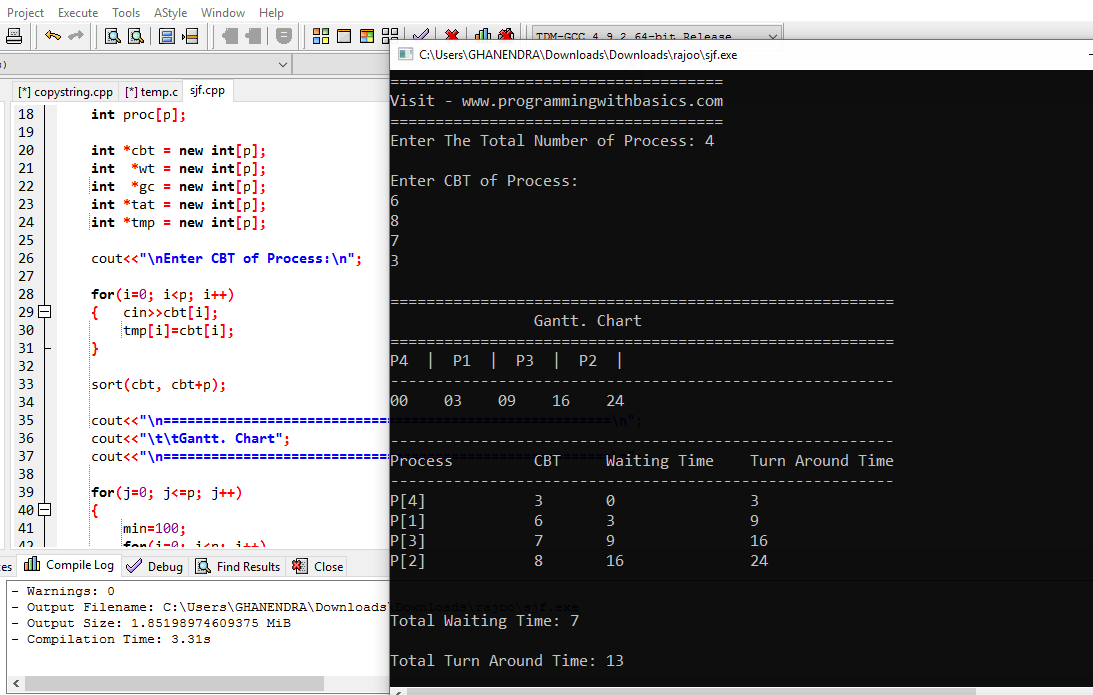In simple word, we can say that Shortest Job First (SJF) is executed (Put on CPU priority) the only process those have a minimum time for execution.
Shortest Job First (SJF) is a pre-emptive Scheduling Algorithm for execution Process in Minimum time order means, a process has a minimum time for execution execute first and then second minimum time taking process. SJF is an alternative to FCFS(First Come and First Serve) cause it reduces the average waiting time and is also good for Batch systems.
Turn Around Time = Completion Time – Arrival Time
Total Turn Around Time = Turn Around Time / Total Number of Process
With the help of this formula, we can calculate a Turn Around Time of all processes in Queue.
Waiting Time = (Turn Around Time – Burst Time)
Total Waiting Time = Waiting Time / Total Number of Process.
Shortest Job First Scheduling Program in C++ With Gantt Chart
#include <bits/stdc++.h>
using namespace std;
int main()
{
/*Shortest Job First Scheduling C++ */
int p, i, j, sum = 0, min, index;
float awt = 0, atat = 0;
cout << "\nEnter The Total Number of Process: ";
cin >> p;
int proc[p];
int *cbt = new int[p];
int *wt = new int[p];
int *gc = new int[p];
int *tat = new int[p];
int *tmp = new int[p];
cout << "\nEnter CBT of Process:\n";
for (i = 0; i < p; i++)
{
cin >> cbt[i];
tmp[i] = cbt[i];
}
sort(cbt, cbt + p);
cout << "\n========================================================\n";
cout << "\t\tShortest Job First Gantt. Chart";
cout << "\n========================================================\n";
for (j = 0; j <= p; j++)
{
min = 100;
for (i = 0; i < p; i++)
{
if (min > tmp[i] && tmp[i] != -1)
{
min = tmp[i];
index = i;
}
}
gc[j] = sum;
wt[j] = sum;
sum += tmp[index];
tat[j] = sum;
tmp[index] = -1;
if (j == p)
break;
cout << 'P' << index + 1 << " | ";
proc[j] = index + 1;
}
cout << "\n--------------------------------------------------------\n";
sum = 0;
for (j = 0; j <= p; j++)
{
if (gc[j] < 10)
cout << 0;
cout << gc[j] << " ";
sum += gc[j];
}
cout << endl;
atat = (sum *1.0) / p;
cout << "\n--------------------------------------------------------";
cout << "\nProcess\t\tCBT\tWaiting Time\tTurn Around Time";
cout << "\n--------------------------------------------------------\n";
for (i = 0; i < p; i++)
{
cout << "P[" << proc[i] << "]\t\t" << cbt[i] << "\t" << wt[i] << "\t\t" << tat[i] << endl;
awt = awt + wt[i];
}
awt = (awt *1.0) / p;
cout << "\n\nTotal Waiting Time: " << awt;
cout << "\n\nTotal Turn Around Time: " << atat << endl;
return 0;
}Shortest Job First Scheduling
- What is the Shortest Job First (SJF) Scheduling Algorithm?.
- How to Calculate Turn-Around Time?.
- How to Calculate Waiting Time?.
- SJF Scheduling Example
1. What is the Shortest Job First (SJF) Scheduling Algorithm?.
Shortest Job First (SJF) is a pre-emptive Scheduling Algorithm for execution Process in Minimum time order means, a process has a minimum time for execution execute first and then second minimum time taking process. SJF is an alternative to FCFS(First Come and First Serve) cause it reduces the average waiting time and is also good for Batch systems.
2. How to Calculate Turn-Around Time in SJF Scheduling?.
Turn Around Time = Completion Time – Arrival Time
Total Turn Around Time = Turn Around Time / Total Number of Process
With the help of this formula, we can calculate a Turn Around Time of all processes in Queue.
3. How to Calculate Waiting Time in SJF Scheduling?.
Waiting Time = (Turn Around Time – Burst Time)
Total Waiting Time = Waiting Time / Total Number of Process.
4. SJF Scheduling Example
We are taking 4 processes whose CBT, or Burst Time Is 6, 8, 7, and 3 respectively and the output is given below.
Enter The Total Number of Processes: 4
Enter CBT of Process:
6
8
7
3
========================================================
Gantt. Chart
========================================================
P4 | P1 | P3 | P2 |
--------------------------------------------------------
00 03 09 16 24
--------------------------------------------------------
Process CBT Waiting Time Turn Around Time
--------------------------------------------------------
P[4] 3 0 3
P[1] 6 3 9
P[3] 7 9 16
P[2] 8 16 24
Total Waiting Time: 7
Total Turn Around Time: 13
Enter The Total Number of Processes: 4
Enter CBT of Process:
6
8
7
3
========================================================
Gantt. Chart
========================================================
P4 | P1 | P3 | P2 |
--------------------------------------------------------
00 03 09 16 24
--------------------------------------------------------
Process CBT Waiting Time Turn Around Time
--------------------------------------------------------
P[4] 3 0 3
P[1] 6 3 9
P[3] 7 9 16
P[2] 8 16 24
Total Waiting Time: 7
Total Turn Around Time: 13











![Structure Program For Student Details in C [Using Structure] Structure Program For Student Details in C [Using Structure]](https://blogger.googleusercontent.com/img/b/R29vZ2xl/AVvXsEia18_2AFR02YTHxDT4P5CZj8CrScKHBklTbxxwUfkG1iMFhISy_4HsJ61VoliPnCxqTZuKz8K4phrELLrPBzg6EI6acbZTi9X--Zo1ZE6Nm8fdcE189o3LZyaJY13K-KDDFpm4XbzJ6rjxZwkplE-KSseoEXHuYpTGZRoyQGtpAdCr1kcEvVoTWP0Y/s72-c/Structure%20Program%20For%20Student%20Details%20in%20C.jpg)



0 Comments: